
- •Contributors
- •Table of Contents
- •Preface
- •Technical requirements
- •Installing a Power BI gateway
- •Getting ready
- •How it works
- •Authentication to data sources
- •Getting ready
- •How it works
- •Main challenges that Power Query solves
- •Getting ready
- •Technical requirements
- •Getting data and connector navigation
- •Getting ready
- •Creating a query from files
- •Getting ready
- •How it works...
- •Creating a query from a folder
- •Getting ready
- •How it works...
- •Creating a query from a database
- •Getting ready
- •How it works...
- •Creating a query from a website
- •Getting ready
- •How it works...
- •Technical requirements
- •Exploring Power Query Editor
- •Getting ready
- •Managing columns
- •Getting ready
- •Using data profiling tools
- •Getting ready
- •Using Queries pane shortcuts
- •Getting ready
- •Using Query Settings pane shortcuts
- •Getting ready
- •Using Schema view and Diagram view
- •Getting ready
- •Technical requirements
- •Formatting data types
- •Getting ready
- •Using first rows as headers
- •Getting ready
- •Grouping data
- •Getting ready
- •Unpivoting and pivoting columns
- •Getting ready
- •Filling empty rows
- •Getting ready
- •Splitting columns
- •Getting ready
- •Extracting data
- •Getting ready
- •Parsing JSON or XML
- •Getting ready
- •Exploring artificial intelligence insights
- •Getting ready
- •Technical requirements
- •Merging queries
- •Getting ready
- •Joining methods
- •Getting ready
- •Appending queries
- •Getting ready
- •Combining multiple files
- •Getting ready
- •Using the Query Dependencies view
- •Getting ready
- •Technical requirements
- •Setting up parameters
- •Getting ready
- •Filtering with parameters
- •Getting ready
- •Folding queries
- •Getting ready
- •Leveraging incremental refresh and folding
- •Getting ready
- •Disabling query load
- •Getting ready
- •Technical requirements
- •Using M syntax and the Advanced Editor
- •Getting ready
- •Using M and DAX – differences
- •Getting ready
- •Using M on existing queries
- •Getting ready
- •Writing queries with M
- •Getting ready
- •Creating tables in M
- •Getting ready
- •Leveraging M – tips and tricks
- •Getting ready
- •Technical requirements
- •Adding columns from examples
- •Getting ready
- •Adding conditional columns
- •Getting ready
- •Adding custom columns
- •Getting ready
- •Invoking custom functions
- •Getting ready
- •Clustering values
- •Getting ready
- •Technical requirements
- •Using Power BI dataflows
- •Getting ready
- •Centralizing ETL with dataflows
- •Getting ready
- •Building dataflows with Power BI Premium capabilities
- •Getting ready
- •Understanding dataflow best practices
- •Getting ready
- •Technical requirements
- •Exploring diagnostics options
- •Getting ready
- •Managing a diagnostics session
- •Getting ready
- •Designing a report with diagnostics results
- •Getting ready
- •There's more…
- •Using Diagnose as a Power Query step
- •Getting ready
- •Other Books You May Enjoy
- •Index
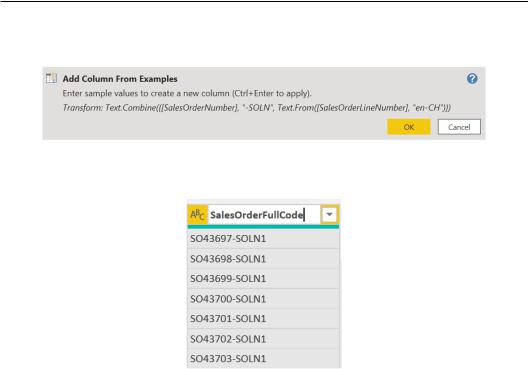
278Adding Value to Your Data
5.See how the concatenation was performed by having a look at the M code applied, and then click on OK.
Figure 8.15 – M code generated by the step
6. At the end, rename the column SalesOrderFullCode.
Figure 8.16 – Column renaming
Adding columns from examples offers different options when you do not want to code directly with M or when you know exactly what the desired output is but you are not sure which transformation options in Power Query to use.
Adding conditional columns
You can also enrich your queries by adding columns with if…then logic and applying some conditions based on existing columns. These are called conditional columns and this feature allows you to implement conditional expressions with an intuitive interface. In this recipe, you will see how it is easy to apply custom flags based on the values of existing columns.
Getting ready
For this recipe, you need to download the FactInternetSales CSV file. In this example, we will refer to the C:\Data folder.
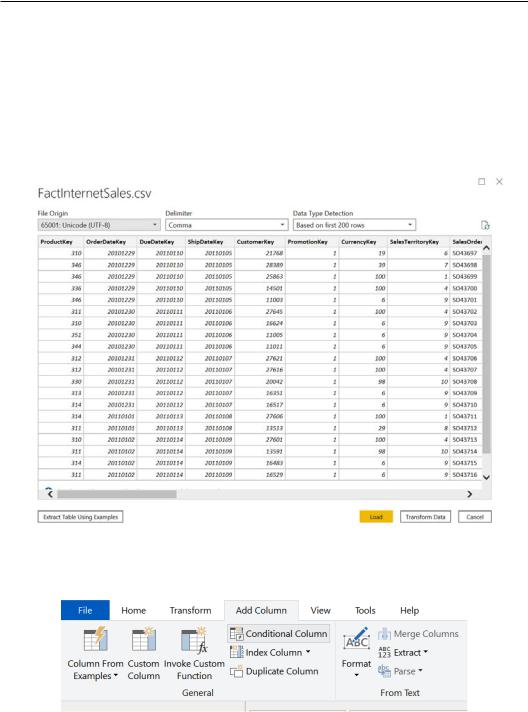
Adding conditional columns 279
How to do it…
Once you open your Power BI Desktop application, you are ready to perform the following steps:
1.Click on Get data and select the Text/CSV connector.
2.Browse to your local folder where you downloaded the FactInternetSales CSV file and open it. The following window with a preview of the data will pop up; click on Transform Data:
Figure 8.17 – CSV data preview
3. Browse to the Add Column tab and click on Conditional Column.
Figure 8.18 – Conditional Column button
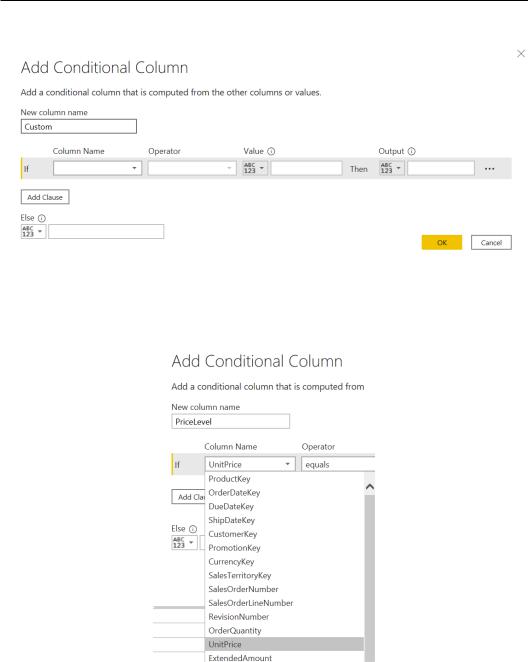
280Adding Value to Your Data
4.The Add Conditional Column window will pop up, as in the following screenshot:
Figure 8.19 – Add Conditional Column window
5.Name the new column PriceLevel and start creating the first condition by selecting UnitPrice from the first dropdown after If.
Figure 8.20 – Defining the condition
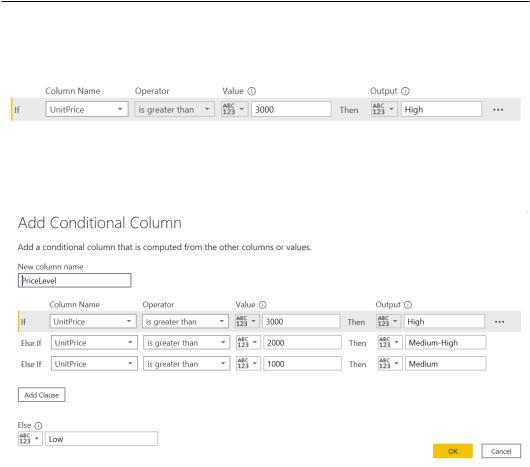
Adding conditional columns 281
6.Then select is greater than from the Operator dropdown and enter 3000 for Value and High for Output, as in the following example, in order to label unit prices higher than 3000 with the High flag:
Figure 8.21 – Defining Value and Output
7.Then, click on Add Clause in order to add another two conditions and fill them in, as in the following screenshot. At the end, click on OK.
Figure 8.22 – Defining multiple conditions
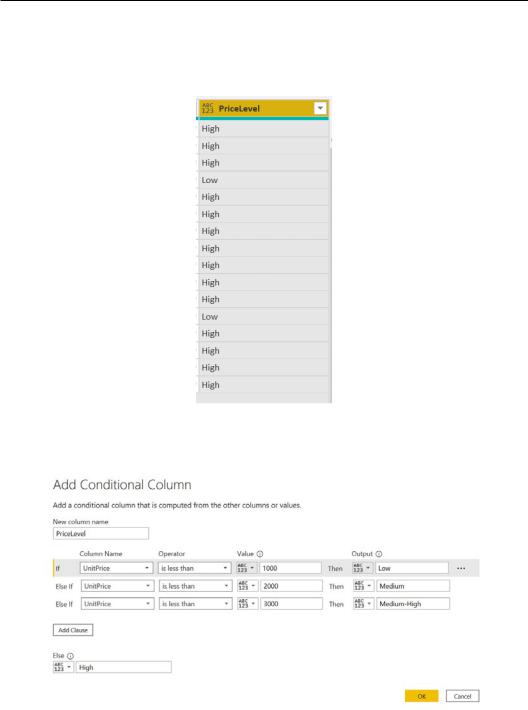
282 Adding Value to Your Data
With this example, we are stating that products with UnitPrice higher than 3000 have to be labeled as High, between 2000 and 3000 as Medium-High, and between 1000 and 2000 as Medium, and if any of these conditions are not met, the label should be Low (defined by the input in the Else section on the bottom left in the preceding figure).
Figure 8.23 – New column created
The same PriceLevel column output could be achieved by setting up the conditions as follows:
Figure 8.24 – Defining a different order
